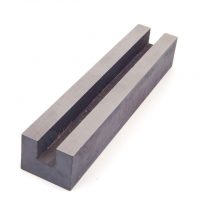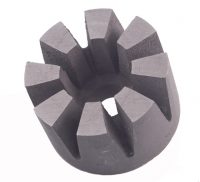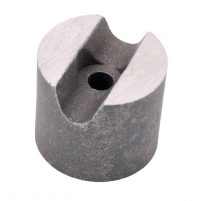
Alnico is a common and very commercially mature magnet alloy comprised of Aluminum, Nickel, Cobalt, Titanium and Iron. (There are also small amounts of various other elements including, but not limited to; copper, silicon, columbium, and zirconium.)
Alnico has a very high Residual Induction (Br). This characteristic of a magnet offers a sense of how large/strong of a magnetic field a particular magnet alloy can generate. Typically, the higher the Residual Induction, the larger, more dense the magnetic field can be generated by a magnet.
When any magnet is said to be “Magnetized,” that means that virtually all areas of the magnet are contributing to the net magnetic field. These small areas called domains then “point” in the same direction. When only some areas point in the same direction and others do not “contribute,” the magnet is partially magnetized. And finally, when all of the domains are randomized and point in different directions, the magnet is demagnetized, as there is no net usable magnetic field.
Most materials, including permanent magnets, do not desire to be magnetized as there is a great internal struggle between the domains. Remaining in the Magnetized state means that the magnet will reside at a higher energy level. The magnet actually wishes to shed the orientation of its domains and achieve a lower energy state.
There is domain alignment within a piece of steel when a magnetic field is applied, but it is immediately destroyed when the external field is removed. Various metallurgical mechanisms within the magnet help make an Alnico magnet “permanent” and not an expensive piece of electrical iron.
Self-Demagnetization occurs the moment the magnetizing field is removed from the magnet after the magnetizing process. Just as two magnets do not like their common poles forced together, there are internal forces within the magnet trying to demagnetize the magnet and “dive off” the magnetic orientation. The success of these internal self-demagnetizing forces depends upon the magnet ability to resist the forces, the shape/size of the magnet, and the operating environment.
 The rating of how well a magnet resists demagnetization, especially “Self-Demagnetization,” is called the magnet’s Coercive Force (Hc). The higher the Coercive Force, the better a magnet will withstand the self-demagnetizing forces. Again, think of these forces as trying to hold a handful of repelling magnets. They will want to flip and re-orient themselves to achieve a lower energy state where they do not repel, but actually attract. This attracting condition greatly reduces the net field and they reduce the usefulness of the magnet.
The rating of how well a magnet resists demagnetization, especially “Self-Demagnetization,” is called the magnet’s Coercive Force (Hc). The higher the Coercive Force, the better a magnet will withstand the self-demagnetizing forces. Again, think of these forces as trying to hold a handful of repelling magnets. They will want to flip and re-orient themselves to achieve a lower energy state where they do not repel, but actually attract. This attracting condition greatly reduces the net field and they reduce the usefulness of the magnet.
Magnet alloy that is susceptible to self-demagnetization needs to be magnetically long compared to the pole area. For instance, a 1/8” outside diameter magnet that is ½” long and oriented through the ½” will resist the self-demagnetizing effects better that a magnet ¼” long. There is a ratio, the Magnetic Length / Diameter (L/D), which is used to judge the degree of self-demagnetizing a magnet will encounter. For Alnico 5, the ideal L/D is approximately 4. Meaning the Alnico magnets perform best when their magnetic length is 4 times their pole area. (For Square and Rectangles, one can calculate the equivalent diameter for the magnet’s cross-section.)
There are other Demagnetizing forces other than “self” or geometry based forces. Heat is a major variable in a magnet’s performance, but Alnico has the highest heat tolerance of all commercial alloys and this is usually not an issue. Another major demagnetizing force occurs because of external magnetic fields. These external fields can be established by coils, neighboring permanent magnets, etc. The magnetic characteristic which gives insight into a magnetic ability to tolerate these external fields is the Intrinsic Coercive Force (Hci).
 Both the Residual Induction (Br) and the Coercive Force (Hc) are important in determining a magnet alloy’s performance in an application and these magnetic characteristics are the key differences in Alncio 5 and Alncio 8. A magnet must have reasonable Magnetic Induction and Coercive Force to be useful. Strong magnets that easily demagnetize are not useful, nor are weak magnets that are difficult to demagnetize.
Both the Residual Induction (Br) and the Coercive Force (Hc) are important in determining a magnet alloy’s performance in an application and these magnetic characteristics are the key differences in Alncio 5 and Alncio 8. A magnet must have reasonable Magnetic Induction and Coercive Force to be useful. Strong magnets that easily demagnetize are not useful, nor are weak magnets that are difficult to demagnetize.
One obvious question that may be asked is why does an Alnico 5 magnet have a similar Residual Induction as some Rare Earth magnets like Neodymium Iron Boron, but are apparently weaker than the Rare Earth magnets? This is because the Rare Earth magnets have a much higher Coercive Force. As described above, their self-demagnetization impact is much lower when the alloy has a high Coercive Force. Large magnetic fields can be generated with Alncio 5, but the magnet must be very magnetically long and use iron / steel elements to help reduce the effects of self-demagnetization.
How is Alnico 8 different from Alnico 5 Magnets?
This ability to resist self-demagnetization and having a higher Coercive Force is why Alnico 5 and Alnico 8 perform differently depending upon the operational environment. The tables below illustrate the magnetic characteristic difference between Alnico 5 and 8. Alnico 5 has a higher Residual Induction, but a lower Coercive Force. Alnico 8 has a lower Residual Induction, but a higher Coercive Force. This immediately suggests that Alnico 8 will have a larger magnetic field compared to Alnico 5 when magnets are short compared to their pole area.
However, when the magnet geometry is ideal or the magnet is used with iron / steel elements in a magnetic circuit, then the Alnico 5 magnets may generate a stronger magnetic field. A good example of this is a horseshoe magnet. A horseshoe magnet has a very long magnetic length and benefits from the NORTH and SOUTH poles being close to each other. (Most horseshoe magnets are made of Alnico 5.)
Material Differences between Alnico 5 and 8:
| CHEMICAL COMPOSITION | |||||
|---|---|---|---|---|---|
| Original MMPA Class | Chemical Composition*+ | ||||
| Aluminum (Al) | Nickel (Ni) | Cobalt (Co) | Copper (Cu) | Titanium (Ti) | |
| Alnico 5 | 8 | 14 | 24 | 3 | - |
| Alnico 8 | 7 | 15 | 35 | 4 | 5 |
| MAGNETIC PROPERTIES | ||||||||
|---|---|---|---|---|---|---|---|---|
| Original MMPA Class | Magnetic Properties (Nominal) | Magnetic Properties (Nominal) | ||||||
| Max. Energy Product (BH)max | Residual Induction Br | Coercive Force Hc | Intrinsic Coercive Force Hci |
|||||
| MGOe | kJ/m3 | Gauss | mT | Oersteds | kA/m | Oersteds | kA/m | |
| Alnico 5 | 5.5 | 43.8 | 12800 | 1280 | 640 | 51 | 640 | 51 |
| Alnico 8 | 5.3 | 42.2 | 8200 | 820 | 1650 | 131 | 1860 | 148 |
| PHYSICAL PROPERTIES | |||||||||
|---|---|---|---|---|---|---|---|---|---|
| Original MMPA Class | Density | Tensile Strength | Transverse Modulus of Rupture | Hardness (Rockwell C) | Coefficient of Thermal Expansion 10-6/°C | Electrical Resistivity Ohm-cm X 10-6 (at 20°C) |
|||
| lbs./in | g/cm3 | psi | Pa X 106 | psi | Pa X 106 | ||||
| Alnico 5 | 0.264 | 7.3 | 5,400 | 37 | 10,500 | 72 | 50 | 11.4 | 47 |
| Alnico 8 | 0.262 | 7.3 | 10,000 | 69 | 30,000 | 207 | 55 | 11.0 | 53 |
Takeaways and Items for Consideration:
- While both Alnico 5 and 8 are brittle, the crystal structure of 8 makes it even more prone to chipping. This should be considered when designing with any Alnico above 6. (This is also true for Alnico 5-7 and 9.)
- Both Alnico 5 and 8 will operate well in elevated temperatures.
- Alnico 5 will offer higher net fields if there is not a geometry restriction.
- Alnico 8 will offer much better resistance to demagnetization from less than ideal geometries.

